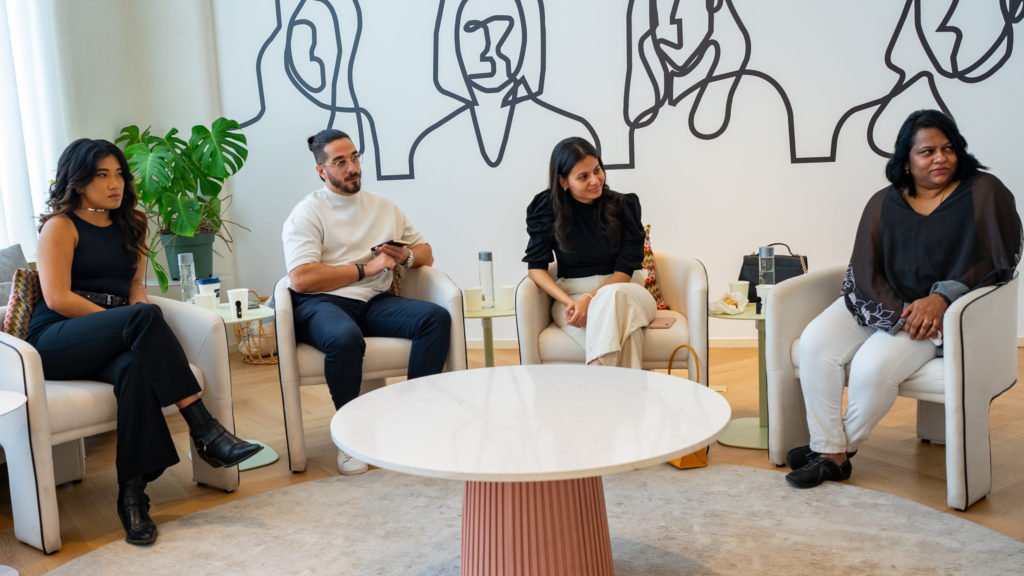Societal consciousness
Do we, as humans, feel the need to take responsibility for our actions?
Take plastic for instance. It hurts the earth and pollutes it in ways beyond our comprehension. Yet, its ubiquitous nature is what forces us to use it and surround ourselves with it. Just look around you and you will see it everywhere – milk jugs, candy wrappers, food packaging… the list is endless. We all know it is bad and yet, what effort are we making to reduce its impact?
This thought process reflects a collective societal consciousness.

Award winning designer Indu Varanasi of i r design studio has won competitions for retail, corporate and public sector projects. She is also listed amongst the Top 50 Most Influential Designers in the region.
The designer’s consciousness
Designers too, are constantly tasked with defining the social fabric of their city through spatial allocation. We do this by learning how the inner mechanism of a city works, how people get from place to place, and where they live, work and play. These subtle inter-linkages make a difference to countless lives. At a microcosm, the inside of these built environments also plays a crucial role in shaping our lives and well being, and affecting us each day.
The word consciousness refers to our awareness of the environment. Being aware of our designs allows us to constantly strive for change and ultimately become better at what we do, and create better things. When we work consciously and anticipate the reaction, the design manifests itself in a different ways.
“It is important that we keep reminding ourselves that we are not designing for the virtual world, but the real one. We need to design with care for our earth as well as ourselves.”
Inner consciousness
In many situations, we react through our sensory organs in visible and invisible ways. We reflect these thoughts through behaviour that tries to improve the situation– if it’s too chilly, we put on something warm, and if something displeases us visually, we silently critique it.
While these behaviours are physical reactions to our surroundings, there is also a subconscious reaction to everything our senses capture – the underlying previous experiences, that gut feeling, logic, purpose, common sense or déjà vu– all of which create an impression that affects our actions.
As designers, the question we should ask ourselves is, isn’t it possible to predict and design these responses?
The answer to that is, it is possible and we do. We have the skill to design spaces for people’s well being, but this act holds us morally responsible for them as well.

The senses and the consciousness
In touch…
When it comes to material, we need to choose carefully based on factors like durability, resistance to abrasion, etc. Depending on the kind of space we intend to design, we need to determine which material best radiates a type of aesthetic. Moreover, the material should meet construction requirements as well. You cannot feel this through a picture, and it is important that we keep reminding ourselves that we are not designing for the virtual world, but the real one. We need to design with care for our earth as well as ourselves.
In sound…
Sound travels through space and material. Hence, designers need to be conscious about whether the space will be subject to loud sounds. The design should convey the needs of the space, the need for sound absorption, reflection, attenuation, legibility, etc. Cinemas and auditoriums, for example, require sound specialists. However, the same sound can be disruptive in an office, meeting room or restaurant. This is where the consciousness of the designer plays a role without any measurable parameters.
In smell…
Similarly, the collective sensual experience when entering a space also includes the smell. Walking into an office lobby filled with the scent of freshly brewed coffee versus one pregnant with stale air from the previous day’s food, makes all the difference to an experience. Smell can be used to entice and create experiences. Knowing its capabilities and the impact it can create is the key to good design. Just because it cannot be measured, it should not be ignored.
In sight…
Light is something so beautiful and adds life everywhere it travels. Our design should be conscious of the fact that daylight can be harnessed to create interior solutions. The introduction of LED lamps was supposed to reduce energy consumption. Instead, the energy consumption remains the same, but the number of light fixtures have increased, creating sleep disorders and ecological imbalances. If we study light levels based on need and usage patterns, we may not need so many light fittings perforating ceilings everywhere. It would also make us more conscious of the design process and the desired result, and hence give the us the ability to create better spaces.
In temperature…
Spatial temperature also falls into the category of consciousness. The ideal temperature in a room should be between 20 and 24 degrees centigrade. However settings are often found at 16 to 18 degrees and air conditioning systems located right above workstations and seating areas, which is in direct contrast with the original concept of air conditioning – to condition the air to a comfortable temperature. Temperature should never be uncomfortable or even noticeable. As a conscious designer, we need to consider locations over calculated heat loads.







